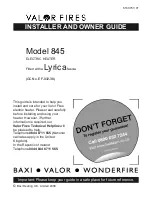
English
INSTRUCTIONS FOR INSTALLATION
9
Screw the wall duct firmly into position with two nuts
while turning the mounting plate and the wall grille to the
correct position (the two bolts on the mounting plate
and the tension rods should be horizontal).
Slide the mounting plate into the position previously
marked on wall.
The exterior wall duct with telescopic inlet
pipe
This is suitable for wall thicknesses of 250 – 440 mm
without shortening the parts of the inlet pipe. By short-
ening the pipe’s parts, this exterior wall duct can be
adapted for thicknesses of 70 – 250 mm.The outlet pipe
should be adjusted.The tension members attached to the
wall grid can be shortened after the wall duct has been
mounted. If the telescopic inlet pipe is applied for wall
thicknesses of 70 – 250 mm, both parts of the pipe
should be shortened, i.e.:
• the part of the inlet pipe on the side of the wall grid
equal to the thickness of the wall
• the part of the pipe on the side of the heater to a length
equalling the wall thickness minus 20 mm.
CAUTION:
do not cut the pipe parts on the side
where the fastening clamps have been applied.
Installation of the wall duct with telescopic
inlet pipe (fig. 1)
From the outside, put the wall grid, together with the
attached half inlet pipe into the created wall opening,
keeping "Top" up when placing the wall grid. Slide the
other half of the inlet pipe through the mounting sheet
(2), making sure that the inserted fastening clamps (3) lie
on the horizontal centre line (see the marks in the
mounting sheet).They should catch on the turned-back
edge of the mounting sheet.
From the inside, slide the half inlet pipe through the cre-
ated wall opening into the part of the inlet pipe already
mounted.While doing so, make sure the the two tension
members (4) stick through the fastening clamps (3). Press
the mounting sheet up to the wall. Appply the screw-nuts
onto the tension members (4) and tighten them by hand
against the fastening clamps (3).
Installation against a combustible wall
Marking the position of the wall duct on the wall is done
in the same way as for a non-combustible wall.
Make a 280 mm square hole through the outer wall, at
the centre of the round hole in the mounting plate.
If it is a cavity wall, fill the cavity well so that the sections
do not get compressed.
Fit the extra silumin plate with 4 screws onto the outside
of the wall.
This extra plate, to enable the duct to be used on a com-
bustible wall, is available as a separate order.
The wall duct is then fitted in the same manner as
described for a non-combustible wall.
N.B.
To calculate the length of the inlet and outlet pipe,
the thickness of siluminplate (15) should be included.
Positioning the aluminium shield
When installing the convector the aluminium
shield should be placed under the foot of the inte-
rior. Slide the shield back far enough so that the
front is level with the front of the steel foot.
Positioning the convector
Slide the outlet pipe into the wall grille and stand the
convector on the floor plate.
Slide the convector against the wall so that the outlet fits
over the outlet pipe and the two mounting brackets over
the bolts on the mounting plate.
Screw the two nuts on lightly.
Connection of the gas supply
The connection has a 3/8" BSP inside thread. An approved
connecting tap with coupling should be used in the supply
pipe (For Belgium this should be B.G.V. approved).The
connecting tap with coupling should be fitted outside the
casing. Furthermore:
• Expel all air from the supply pipes/hoses before coupling
to the appliance.
• Do not turn the coupling tap when connecting it to the
gas supply.
• Avoid any pressure on the
control tap and pipes.
• Check that all connections
are gastight.
Glowing coals
The coals have already been
fitted in the factory. Should
they need replacing:
• Remove the 8 nuts.
• Remove the glass.
• Remove the broken coals.
• Evenly distribute the glowing
coals on the grille in the com-
bustion chamber (fig. 3).
• Replace the glass.
• Replace and tighten the 8 nuts.
DVS-2
38c-700
fig. 2
38c-993
fig. 3
Detail of the wall mounting












































